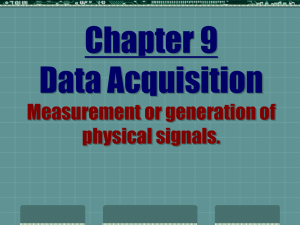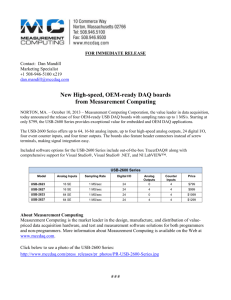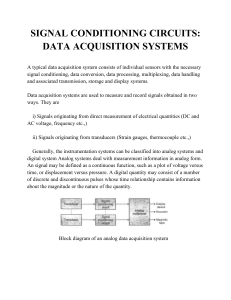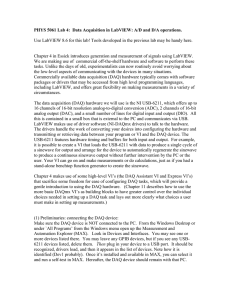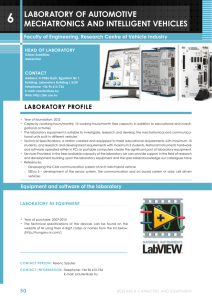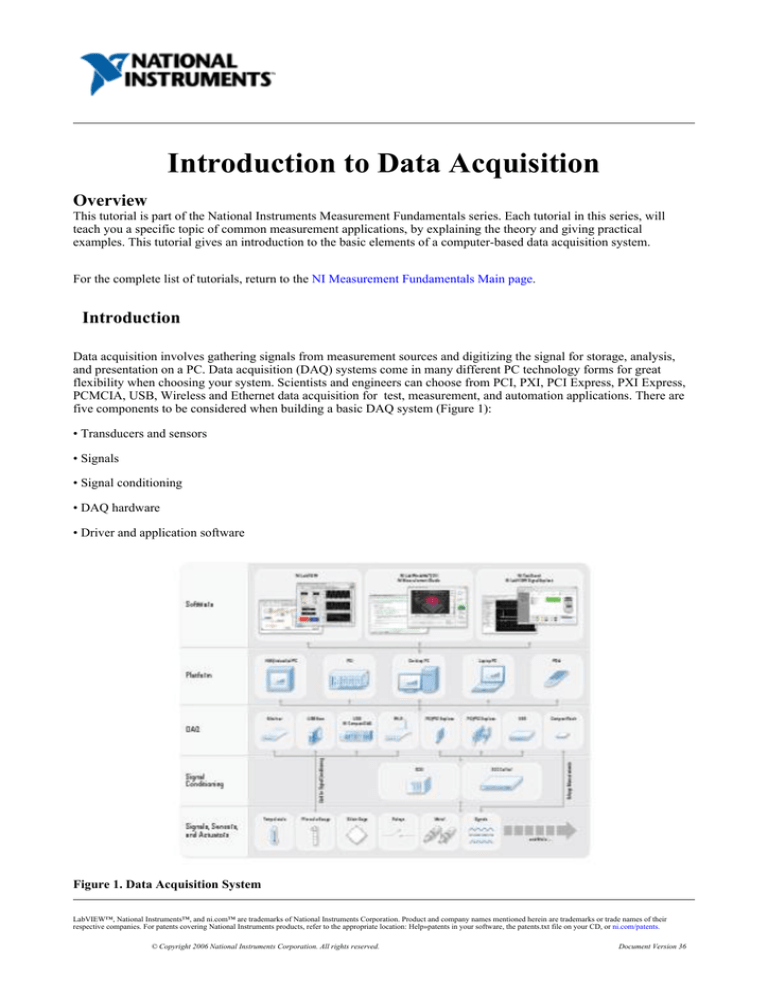
Introduction to Data Acquisition
Overview
This tutorial is part of the National Instruments Measurement Fundamentals series. Each tutorial in this series, will
teach you a specific topic of common measurement applications, by explaining the theory and giving practical
examples. This tutorial gives an introduction to the basic elements of a computer-based data acquisition system.
For the complete list of tutorials, return to the NI Measurement Fundamentals Main page.
Introduction
Data acquisition involves gathering signals from measurement sources and digitizing the signal for storage, analysis,
and presentation on a PC. Data acquisition (DAQ) systems come in many different PC technology forms for great
flexibility when choosing your system. Scientists and engineers can choose from PCI, PXI, PCI Express, PXI Express,
PCMCIA, USB, Wireless and Ethernet data acquisition for test, measurement, and automation applications. There are
five components to be considered when building a basic DAQ system (Figure 1):
• Transducers and sensors
• Signals
• Signal conditioning
• DAQ hardware
• Driver and application software
Figure 1. Data Acquisition System
LabVIEW™, National Instruments™, and ni.com™ are trademarks of National Instruments Corporation. Product and company names mentioned herein are trademarks or trade names of their
respective companies. For patents covering National Instruments products, refer to the appropriate location: Help»patents in your software, the patents.txt file on your CD, or ni.com/patents.
© Copyright 2006 National Instruments Corporation. All rights reserved.
Document Version 36
Transducers
Data acquisition begins with the physical phenomenon to be measured. This physical phenomenon could be the
temperature of a room, the intensity of a light source, the pressure inside a chamber, the force applied to an object, or
many other things. An effective DAQ system can measure all of these different phenomena.
A transducer is a device that converts a physical phenomenon into a measurable electrical signal, such as voltage or
current. The ability of a DAQ system to measure different phenomena depends on the transducers to convert the
physical phenomena into signals measurable by the DAQ hardware. Transducers are synonymous with sensors in DAQ
systems. There are specific transducers for many different applications, such as measuring temperature, pressure, or
fluid flow. Figure 2 shows a short list of some common phenomena and the transducers used to measure them.
Phenomenon
Transducer
Temperature
Thermocouple, RTD, Thermistor
Light
Photo Sensor
Sound
Microphone
Force and Pressure
Strain Gage
Piezoelectric Transducer
Position and Displacement
Potentiometer, LVDT, Optical Encoder
Acceleration
Accelerometer
pH
pH Electrode
Figure 2. Phenomena and Existing Transducers
Different transducers have different requirements for converting phenomena into a measurable signal. Some transducers
may require excitation in the form of voltage or current. Other transducers may require additional components and even
resistive networks to produce a signal. Refer to ni.com/sensors for more information on transducers.
Signals
The appropriate transducers convert physical phenomena into measurable signals. However, different signals need to be
measured in different ways. For this reason, it is important to understand the different types of signals and their
corresponding attributes. Signals can be categorized into two groups:
· Analog
2
www.ni.com
· Digital
Analog Signals
An analog signal can be at any value with respect to time. A few examples of analog signals include voltage,
temperature, pressure, sound, and load. The three primary characteristics of an analog signal include level, shape, and
frequency (Figure 3).
Figure 3. Primary Characteristics of an Analog Signal
Level
Because analog signals can take on any value, the level gives vital information about the measured analog signal. The
intensity of a light source, the temperature in a room, and the pressure inside a chamber are all examples that
demonstrate the importance of the level of a signal. When measuring the level of a signal, the signal generally does not
change quickly with respect to time. The accuracy of the measurement, however, is very important. A DAQ system that
yields maximum accuracy should be chosen to aid in analog level measurements.
Shape
Some signals are named after their specific shape - sine, square, sawtooth, and triangle. The shape of an analog signal
can be as important as the level, because by measuring the shape of an analog signal, you can further analyze the signal,
including peak values, DC values, and slope. Signals where shape is of interest generally change rapidly with respect to
time, but system accuracy is still important. The analysis of heartbeats, video signals, sounds, vibrations, and circuit
responses are some applications involving shape measurements.
3
www.ni.com
Frequency
All analog signals can be categorized by their frequency. Unlike the level or shape of the signal, frequency cannot be
directly measured. The signal must be analyzed using software to determine the frequency information. This analysis is
usually done using an algorithm known as the Fourier transform.
When frequency is the most important piece of information, it is important to consider including both accuracy and
acquisition speed. Although the acquisition speed for acquiring the frequency of a signal is less than the speed required
for obtaining the shape of a signal, the signal must still be acquired fast enough that the pertinent information is not lost
while the analog signal is being acquired. The condition that stipulates this speed is known as the Nyquist Sampling
Theorem. Speech analysis, telecommunication, and earthquake analysis are some examples of common applications
where the frequency of the signal must be known.
Digital Signals
A digital signal cannot take on any value with respect to time. Instead, a digital signal has two possible levels: high and
low. Digital signals generally conform to certain specifications that define characteristics of the signal. Digital signals
are commonly referred to as transistor-to-transistor logic (TTL). TTL specifications indicate a digital signal to be low
when the level falls within 0 to 0.8 V, and the signal is high between 2 to 5 V. The useful information that can be
measured from a digital signal includes the state and the rate (Figure 4).
Figure 4. Primary Characteristics of a Digital Signal
State
Digital signals cannot take on any value with respect to time. The state of a digital signal is essentially the level of the
4
www.ni.com
signal - on or off, high or low. Monitoring the state of a switch - open or closed - is a common application showing the
importance of knowing the state of a digital signal.
Rate
The rate of a digital signal defines how the digital signal changes state with respect to time. An example of measuring
the rate of a digital signal includes determining how fast a motor shaft spins. Unlike frequency, the rate of a digital
signal measures how often a portion of a signal occurs. A software algorithm is not required to determine the rate of a
signal.
Signal Conditioning
Sometimes transducers generate signals too difficult or too dangerous to measure directly with a DAQ device. For
instance, when dealing with high voltages, noisy environments, extreme high and low signals, or simultaneous signal
measurement, signal conditioning is essential for an effective DAQ system. Signal conditioning maximizes the accuracy
of a system, allows sensors to operate properly, and guarantees safety.
It is important to select the right hardware for signal conditioning. Signal conditioning is offered in both modular and
integrated forms (Figure 5). Signal conditioning accessories can be used in a variety of applications including:
· Amplification
· Attenuation
· Isolation
· Bridge completion
· Simultaneous sampling
· Sensor excitation
· Multiplexing
For more detailed information on these types of signal conditioning, visit Signal Conditioning Fundamentals for
Computer-Based Data Acquisition Systems
Other important criteria to consider with signal conditioning include packaging (modular versus integrated),
performance, I/O count, advanced features, and cost. Use online tools at ni.com/signalconditioning to configure the
best signal conditioning solution for your application.
5
www.ni.com
Figure 5. Signal Conditioning Hardware Options
DAQ Hardware
DAQ hardware acts as the interface between the computer and the outside world. It primarily functions as a device that
6
www.ni.com
digitizes incoming analog signals so that the computer can interpret them. Other data acquisition functionality includes:
· Analog Input/Output
· Digital Input/Output
· Counter/Timers
· Multifunction - a combination of analog, digital, and counter operations on a single device
National Instruments offers several hardware platforms for data acquisition. The most readily available platform is the
desktop computer. National Instruments offers PCI DAQ boards that plug into any desktop computer. In addition, NI
makes DAQ modules for PXI/CompactPCI, a more rugged modular computer platform specifically for measurement
and automation applications. For distributed measurements, the National Instruments Compact FieldPoint platform
delivers modular I/O, embedded operation, and Ethernet communication. For portable or handheld measurements,
National Instruments DAQ devices for USB and PCMCIA work with laptops or Windows Mobile PDAs (Figure 6). In
addition, National Instruments has launched DAQ devices for PCI Express, the next generation PC I/O bus and for PXI
Express, the high performance PXI bus.
Figure 6. DAQ Hardware Options
7
www.ni.com
The newest DAQ devices from National Instruments offer connectivity over Wireless and cabled Ethernet. NI Wi-Fi
DAQ devices combine IEEE 802.11g wireless or Ethernet communication; direct sensor connectivity; and the flexibility
of NI LabVIEW software for remote monitoring of electrical, physical, mechanical, and acoustical signals.
View the 6-minute NI Wi-Fi DAQ Guided Tour
Figure 7. Wi-Fi Data Acquisition
Driver and Application Software
8
www.ni.com
Driver Software
Software transforms the PC and the DAQ hardware into a complete data acquisition, analysis, and presentation tool.
Without software to control or drive the hardware, the DAQ device will not work properly. Driver software is the layer
of software for easily communicating with the hardware. It forms the middle layer between the application software and
the hardware. Driver software also prevents a programmer from having to do register-level programming or
complicated commands in order to access the hardware functions. National Instruments offers two different software
options:
· NI-DAQmx driver and additional measurement services software
· NI-DAQmx Base driver software
With the introduction of NI-DAQmx, National Instruments revolutionized DAQ application development by greatly
increasing the speed at which you can move from building a program to deploying a high-performance measurement
application. DAQ Assistant, included with NI-DAQmx, is a graphical, interactive guide for configuring, testing, and
acquiring measurement data. With a single click, you can even generate code based on your configuration, making it
easier and faster to develop complex operations. Because DAQ Assistant is completely menu-driven, you will make
fewer programming errors and drastically decrease the time from setting up your DAQ system to taking your first
measurement.
NI-DAQmx Base offers a subset of NI-DAQmx functionality on Windows and Linux, Mac OS X, Windows Mobile and
Windows CE.
Application Software
The application layer can be either a development environment in which you build a custom application that meets
specific criteria, or it can be a configuration-based program with preset functionality. Application software adds
analysis and presentation capabilities to driver software. To choose the right application software, evaluate the
complexity of the application, the availability of configuration-based software that fits the application, and the amount
of time available to develop the application. If the application is complex or there is no existing program, use a
development environment.
NI offers three development environment software products for developing complete instrumentation, acquisition, and
control applications:
· LabVIEW with graphical programming methodology
· LabWindows™/CVI™ for traditional C programmers
· Measurement Studio for Visual Basic, C++, and .NET
With the introduction of LabVIEW SignalExpress, NI has introduced a configuration-based software environment
where programming is no longer a requirement. Using LabVIEW SignalExpress, you can make interactive
measurements with NI Express Technology.
Relevant NI Products
Customers interested in this topic were also interested in the following NI products:
9
www.ni.com
•
•
•
LabVIEW
Data Acquisition (DAQ)
Signal Conditioning
For more tutorials, return to the NI Measurement Fundamentals Main page
Linux® is the registered trademark of Linus Torvalds in the U.S. and other countries.
The mark LabWindows is used under a license from Microsoft Corporation. Windows is a registered trademark of
Microsoft Corporation in the United States and other countries.
10
www.ni.com


